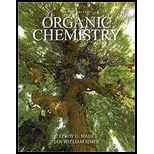
Concept explainers
(a)
To determine: The stability of the isomers of the given compound and the amount of energy that makes one of them stable.
Interpretation: The stability of the isomers of the given compound is to be determined and the amount of energy that makes one of them stable is to be calculated.
Concept introduction: The stability of
Heat of hydrogenation of an alkene is the standard enthalpy for the catalytic hydrogenation of the alkene. The value of heat of hydrogenation is always negative.
(b)
To determine: The stability of the given compound and the amount of energy that makes one of them stable.
Interpretation: The stability of the given compound is to be determined and the amount of energy that makes one of them stable is to be calculated.
Concept introduction: The stability of alkenes depends on the structure of alkene. The energy of alkene is measured by their heat of hydrogenation. More the heat of hydrogenation, more stable is the alkene.
Heat of hydrogenation of an alkene is the standard enthalpy for the catalytic hydrogenation of the alkene. The value of heat of hydrogenation is always negative.
(c)
To determine: The stability of the given compounds and the amount of energy that makes one of them stable.
Interpretation: The stability of the given compound is to be determined and the amount of energy that makes one of them stable is to be calculated.
Concept introduction: The stability of alkenes depends on the structure of alkene. The energy of alkene is measured by its heat of hydrogenation. More the heat of hydrogenation, more stable is the alkene.
Heat of hydrogenation of an alkene is the standard enthalpy for the catalytic hydrogenation of the alkene. The value of heat of hydrogenation is always negative.
(d)
To determine: The stability of the isomers of the given compound and the amount of energy that makes one of them stable.
Interpretation: The stability of the isomers of the given compound is to be determined and the amount of energy that makes one of them stable is to be calculated.
Concept introduction: The stability of alkenes is depends on the structure of alkene. The energy of alkene is measured by its heat of hydrogenation. More the heat of hydrogenation, more stable is the alkene.
Heat of hydrogenation of an alkene is the standard enthalpy for the catalytic hydrogenation of the alkene. The value of heat of hydrogenation is always negative.
Want to see the full answer?
Check out a sample textbook solution
Chapter 7 Solutions
ORGANIC CHEMISTRY
- What is the product of the reaction? F3C. CF3 OMe NaOH / H₂Oarrow_forwardWhat would you expect to be the major product obtained from the following reaction? Please explain what is happening here. Provide a detailed explanation and a drawing showing how the reaction occurs. The correct answer to this question is V.arrow_forwardPlease answer the question for the reactions, thank youarrow_forward
- What is the product of the following reaction? Please include a detailed explanation of what is happening in this question. Include a drawing showing how the reagent is reacting with the catalyst to produce the correct product. The correct answer is IV.arrow_forwardPlease complete the reactions, thank youarrow_forwardConsider the synthesis. What is compound Y? Please explain what is happening in this question. Provide a detailed explanation and a drawing to show how the compound Y creates the product. The correct answer is D.arrow_forward
- What would be the major product of the following reaction? Please include a detailed explanation of what is happening in this question. Include steps and a drawing to show this reaction proceeds and how the final product is formed. The correct answer is B. I put answer D and I don't really understand what is going on in the question.arrow_forwardWhat is the product of the following reaction? Please explain what is happening in this question. Provide a detailed explanation and a drawing showing how the reagent is reacting with the catalysts to product the correct product. The correct answer is B.arrow_forwardWhat is the missing intermediate 1 and the final product 2. Please include a detailed explanation explaining the steps of malonic ester synthesis. Please include drawings of the intermediate and how it occurs and how the final product is former.arrow_forward
 Organic Chemistry: A Guided InquiryChemistryISBN:9780618974122Author:Andrei StraumanisPublisher:Cengage Learning
Organic Chemistry: A Guided InquiryChemistryISBN:9780618974122Author:Andrei StraumanisPublisher:Cengage Learning
